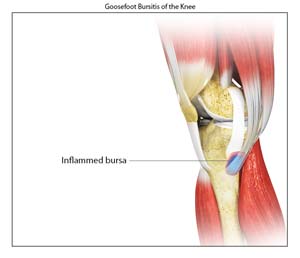
What is Goosefoot Bursitis of the Knee?
A bursa is a small fluid-filled sac found between soft tissues and bones. It lubricates and acts as a cushion, decreasing the friction between bones when they move. Bursitis refers to the inflammation and swelling of the bursa. Goosefoot bursitis or pes anserine bursitis is the inflammation of the bursa present between the tendons of the hamstring muscle and the tibia (shinbone) on the inner side of the knee.
Causes of Goosefoot Bursitis of the Knee
Goosefoot bursitis is often caused due to repetitive friction on the bursa, overuse of the joints during sports, osteoarthritis of the knee, obesity, medial meniscus tear, tight hamstring muscles, and incorrect training techniques.
Symptoms of Goosefoot Bursitis of the Knee
The primary symptom of goosefoot bursitis is pain on the inner side of the knee and/or on the center of the tibia, which may worsen with physical activity.
Diagnosis of Goose Foot Bursitis of the Knee
When you present to the clinic with these symptoms, your doctor diagnoses goosefoot bursitis by ruling out other conditions with a thorough physical examination of your knee and X-ray imaging studies.
Treatment of Goosefoot Bursitis of the Knee
Goosefoot bursitis can be effectively treated with conservative therapy including rest, use of ice packs, anti-inflammatory drugs and injection of steroids at the region of the inflamed bursa to relieve inflammation and pain, and physical exercise to help improve range of motion at the affected region. Surgery is performed only when conservative treatment is ineffective, and involves the removal of the bursa.
Related Topics:
- Knee Pain
- Knee Sprain
- ACL Tears
- Meniscal Tears
- Patellar Instability
- Chondromalacia Patella
- Jumper's Knee
- Kneecap Bursitis
- Baker's Cyst
- Iliotibial Band Syndrome
- Lateral Patellar Compression Syndrome
- Fractures of the Tibia
- Osteochondritis Dissecans of the Knee
- Pediatric ACL Tears
- Shin Splints
- Knee Injury
- Unstable Knee
- Goosefoot Bursitis of the Knee
- MCL Tears
- MCL Sprains
- Meniscal Injuries
- Fractures of the Patella
- Ligament Injuries
- Multiligament Knee Injuries
- Multiligament Instability
- Knee Arthritis
- PCL Injuries
- Chondral or Articular Cartilage Defects
- Patellofemoral Instability
- Patella Fracture
- Recurrent Patella Dislocation
- Quadriceps Tendon Rupture
- Patellar Tendon Rupture
- Lateral Meniscus Syndrome
- Tibial Eminence Spine Avulsion Fracture
- Posterolateral Instability
- Osteonecrosis of the Knee
- Knee Angular Deformities
- Osteochondral Defect of the Knee
- Medial Gastrocnemius Strain
- Articular Cartilage Injury
- Loose Bodies in the Knee
- Knee Fracture
- Knee Osteoarthritis
- Knee Sports Injuries
- Patellar Tendinitis
- Pediatric Tibial Tubercle Fractures
- Women and ACL Injuries
- Medial Meniscus Syndrome
- Adolescent Knee Problems
- Anterior Knee Pain
- Runner's Knee
- Osgood-Schlatter Disease
- Patellar Dislocation/Patellofemoral Dislocation

